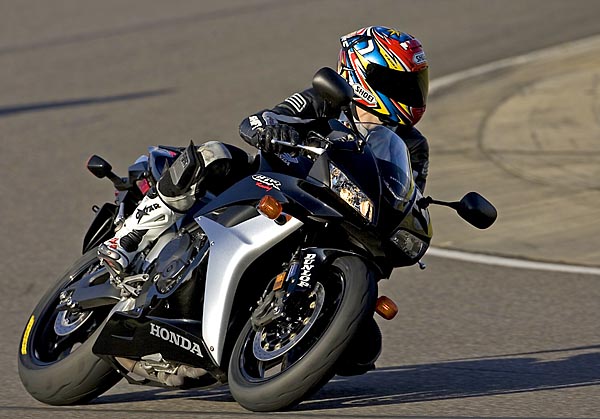
If you read Part One of this ‘First Ride’ (the cynics amongst you might have called it a teaser) of the new CBR600RR on Friday, you know that my initial impression of Honda’s new middleweight sportbike was quite positive. After taking a few days to collect my thoughts, I decided I’d better get to work before I forget about everything except the Barber Vintage Motorsports Museum I toured while a guest of Honda. Yes, it was that amazing. But then, you want to hear about the CBR, don’t you?
While most manufacturers will tell you their latest sportbike was developed starting with a ‘clean sheet of paper’, Honda told us just the opposite at the launch of the new CBR600RR – claiming that not only does their new middleweight feature current MotoGP technology, but that it was developed concurrently and in close parallel with their new 800cc MotoGP machine. In at least one area, my riding experience bore that out, but more on that later.
Honda’s deservedly famous engineering branch concocted a formula that they felt had what it took to dominate the 600cc sportbike class, and set out to drastically reduce both the weight and size of their 600. The motor was totally reconfigured, reducing front-to-rear dimensions by 27.5mm (1.08″) and dropping 3.7lbs off the engine alone. The shorter motor allowed the designers to shorten the bike’s wheelbase by 23mm (.90″) while actually increasing swingarm length (to 22.5″). To complement the new shorter wheelbase, the steering geometry was made even more aggressive – rake was increased from 24 degrees to 23.7 degrees, with trail growing from 95mm to 97.7mm. All this to build a smaller, lighter, quicker-handling motorcycle.
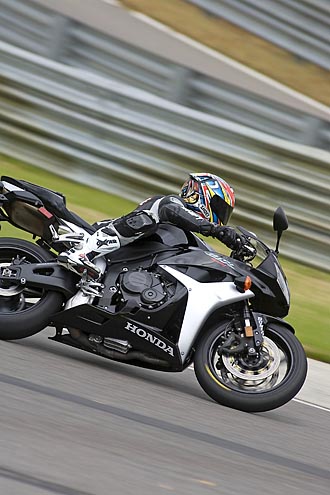
To prevent the more aggressive geometry and shorter wheelbase from causing handling problems, Honda implemented the latest version of its Honda Electronic Steering Damper (HESD). In keeping with the theme of the bike, the latest generation HESD unit is less than half the size and more than 25% lighter than the original HESD systems which debuted a few years ago on the CBR1000RR. The HESD offers variable damping levels based on vehicle speed and acceleration, starting with little resistance at low speeds but firming up when the rider gets into the throttle. The system is now an integral part of Honda’s sportbike chassis design, and several people who were involved in the new CBR’s design and testing told us the sharp-edged new frame geometry wouldn’t have been safe prior to the advent of HESD.
Shrink-wrapping the new, more compact motor is a chassis that has reduced size to fit, being slimmer and more compact than that of the ’05-’06 models. Honda has utilized its latest FDC (Fine Die-Cast) technology to cast the aluminum frame in only four sections (as opposed to 11 on the old bikes) for easier assembly, and a side effect was increased frame strength. This very efficient frame is suspended by 41mm inverted cartridge forks up front (adjustable preload, compression, rebound) and at the rear uses an updated version of the now-familiar Unit Pro-Link first developed for Honda’s MotoGP racebike. This design is claimed to keep the forces exerted by the rear shock localized in the swingarm to allow the rear of the frame to be thinner and thus lighter, while at the same time saving space that is used to carry part of the bike’s fuel load under the seat for mass centralization, another concept Honda emphasized in the design process of their new supersport machine.
Getting into the ’07 CBR600RR’s dynamic riding characteristics, the first thing we’ll cover is handling and suspension. As Honda’s engineers intended, the shorter wheelbase and sharper geometry combine to create a much crisper-turning bike than the previous model. While I had never found the ’06 CBR600RR’s reflexes to be slow or its turn-in reluctant, by comparison with the ’07 they are downright lackadaisical. The crisp, responsive turn-in of the new bike gives the rider an immediate feeling of control, and the steeply angled front end is what some might call an ‘apex-hunter’ – able to be aimed with precision at the inch of pavement the rider wishes it to occupy at the corner’s mid-point. This is true on the OE Dunlop Qualifier street tires, and was enhanced even further when wearing the sticky Dunlop DOT-legal race tires that were mounted for our afternoon sessions. To extend the normal analogy of a ‘razor’, you might say that the CBR allowed its rider to place it so precisely as to target one individual blade of hair on a man’s entire bearded chin. Definitely the type of machine you want on your side when circulating a racetrack at speed.
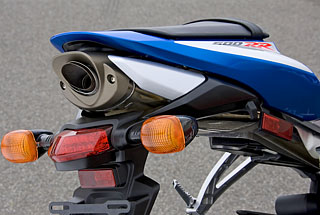
With a little set-up help from Honda ride tester Doug Toland (at 125lbs, I’m significantly lighter than the average adult male), the front forks were doing their job in a competently, dispatching mid-corner and corner-exit bumps as items of little concern. The HESD helped in this department as well, or at least I speculate that it did, as I found the system’s operation to be exactly linear enough to be of no concern to the rider. Despite hard acceleration over a fairly bumpy patch while still somewhat leaned over on corner-exit, the 600RR’s handlebars remained calm and composed in my grip, betraying no hint of the forces being exerted on the newly-sharpened street/track machine.
The one issue I had with the front end was a somewhat annoying lack of feel and feedback. I never had any logical reason to feel that the front end was doing a less than superb job, but of course it isn’t just front end grip that matters, but the rider’s confidence in that front end grip, and in this case I found that somewhat lacking at what was for me the very limit of cornering velocity. However, I can’t put too much stock in my own assessment of maximum cornering velocity, not after witnessing former World Endurance champ Toland peel into turn 15 and, from my perspective, apparently achieve about twenty degrees more lean angle than I was managing in my fastest turn, which 15 certainly wasn’t (there are only a few lefts at Barber, and this being the sharpest, I was careful of what I assumed to be a cold tire). An elegant reminder why I ended up in journalism rather than on the starting grid in a Pro racing field.
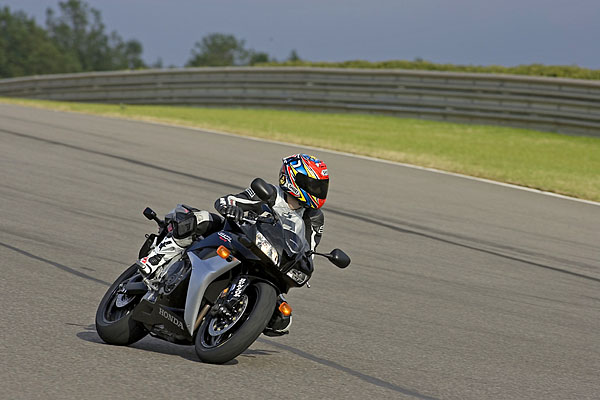
We started the day running on settings developed by Toland and Honda test rider Jeff Tiegert, and although I made some changes to the front end setup with their help, I’m certain that with more time to work, I could have developed a setup that would have offered more of the feedback I wanted. That’s something we’ll have to settle when we get our hands on a bike for street testing.
The rear end, on the other hand, displayed perfect composure throughout the day, all the more so after some setting changes (again with help from Toland – who am I kidding, he did all the work!) in the afternoon which helped the bike work better with my light weight. Even in the morning, on what I later learned to be overly stiff settings, I was perfectly happy with things out back, and plenty of feedback was coming in through the newly-redesigned seat to give me confidence that there was plenty of grip left from the 180 series Dunlop Qualifier. This is the MotoGP-influenced aspect of the bike I referred to earlier in the article – if Honda’s RC211Vs are set up with a similar configuration to their Unit Pro-Link rear suspension, I can understand one of the reasons why that bike has been universally praised as being (relatively, for an intensely powerful, ridiculously light racebike) so easy to ride. I can’t think of a better complement for the revised Unit Pro-Link setup than to say this: suspension that works extremely well when set up with the help of a pro like Toland is great, but suspension that feels pretty damn good even when the settings are way off base is even more valuable in a mass production streetbike. I mean come on, how many of us are really that great at adjusting all those clickers anyway?
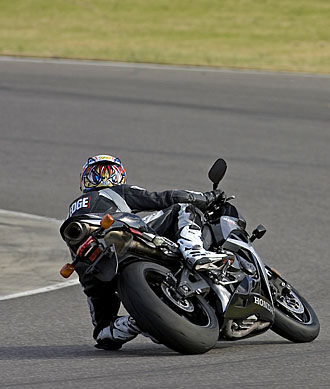
Another huge improvement when lapping Barber came from the new radial-mounted front brake calipers, and their corresponding radial-actuation master cylinder. Again, the issue isn’t one of the ultimate stopping power of the brakes, but one of how much power the rider has the confidence to use. In this respect, I’m starting to become a huge fan of radial-actuation master cylinders, as it seems they work superbly on every bike I’ve sampled them on – offering an increase in feel and feedback that allows me to brake harder, deeper, and more consistently.
Under braking, you can really feel the CBR’s weight loss (a claimed 16lbs), and the work Honda’s engineers put into mass centralization. In the real world, that translates to slowing more quickly and with less weight transfer than the previous bike, and in the area of forward weight transfer, the CBR has perhaps less than any motorcycle I can recall riding. Being used to getting the front suspension deeper into its stroke while standing on the brakes, I was at first unnerved by how flat the bike stayed, and my immediate instinct was to soften the front excessively to get it to move as much as I was used to. In the end, however, I forced myself to adapt, and although I’ve never been a particularly hard braker (this is where the real racers usually pass me), I was able to brake as hard on the new 600RR as on any sportbike I’ve ever ridden. The back brake was there too, and although many racers don’t touch it, I find it useful to drag it lightly to keep the bike settled when braking and just as I turn in. The rear brake on the CBR performed this admittedly minor function without flaw or complaint, and was progressive enough that I don’t believe I locked the rear all day, even for a split second – as sometimes happens when using rear brakes whose action is overly aggressive.
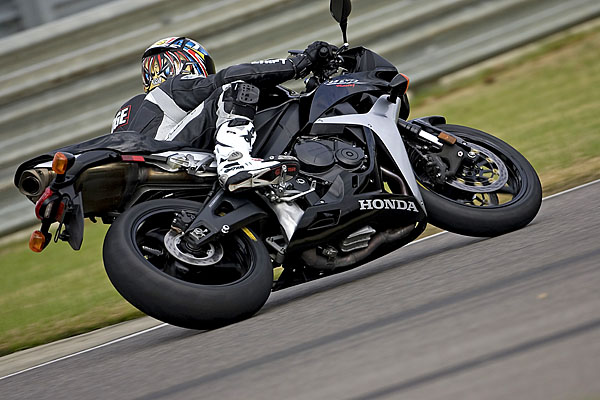
On to the engine. A big part of the new motor’s reduced size came from squeezing and stacking to move the crankshaft, trans input shaft, and trans output shaft closer together, thereby reducing fore-to-aft dimensions. The 3.7lb reduction in engine weight comes in part from the reduced weight of the new, smaller crankcase castings. Additional weight loss comes from the magnesium head covers, new nutless connecting rods, a smaller magnet, a lighter clutch, and countless other small pieces each pared down gram by gram.
Of course, any new sportbike these days is expected to pack increased performance over its predecessors, and the Honda engineers directed efforts in this area as well. The usual evolution of the cylinder head is here, with changes to the shapes of both intake and exhaust ports, as well as the length and taper of the velocity stack on each throttle body. Forged aluminum slipper-type (denoting the minimalist skirt design) pistons are 3.5 percent lighter than before to reduce reciprocating weight, and the skirts feature a molybdenum low-friction coating impregnated into their surface. The lower oil ring is thinner to further reduce friction, and the compression ratio climbs from 12.0 to 12.2:1. High-pressure oil squirters in the crankcase spray oil onto the bottom of the pistons for cooling. The new pistons ride atop redesigned, nutless (meaning the rod bolts thread directly into the rod itself) connecting rods, again reducing reciprocating weight.

The all-new, more powerful engine is managed by a redesigned ECU, and further weight has been saved in the machine’s wiring loom. The ECU programming for the PGM-DSFI is of course different, and is also processed by a more advanced computer system. On the intake side, a redesigned ram-air system picks up air from a large port right in the fairing’s center of pressure, passing through a duct cast into the frame’s steering head and into a larger-volume airbox. Exiting the exhaust ports, combustion gases are evacuated through a new, lighter-weight stainless steel exhaust system, which is equipped with an exhaust valve that can tune the system’s backpressure. This is claimed to increase performance, but is more than likely also helpful in passing sound regulations.
The results of all this work is one of the easiest to ride, most flexible 600 motors I’ve ever had the pleasure to experience. The CBR600RR redlines at 15,000rpm, and horsepower peaks at 13,500rpm – but the motor produces a powerful surge of midrange starting as early as 7000rpm and climbing rapidly as it passes 8000rpm. From there to the power peak at 13,500rpm is basically one linear band of power, which is amazing (an understatement!) from a 600, and I am fairly certain surpasses even Kawasaki’s grunty 2006 636cc ZX-6R (although I’d have to ride them back to back to be certain).
Beyond 13,500rpm the power trails off, but not too steeply, meaning that you have 1500rpm of useful overrev to use rather than shifting up just before a braking point.
The CBR600RR motor is so smooth it could be mistaken for being electric, transmitting absolutely ZERO vibration and with an extremely quiet exhaust note. In fact, this smoothness and lack of sound, combined with the prodigous mid-range power, meant I often forgot what gear I was in (I was mainly using 2nd, 3rd, and 4th around Barber), since the rider-perceived power delivery and noise at 11,000rpm in 2nd isn’t much different from 8,000rpm in third. This motor pulls harder in fourth gear than any middleweight I’ve ever ridden, helped by the new bike’s claimed 16lb weight savings over the previous model. Still, if I bought a new 600RR, I would immediately fit an exhaust (or at least a slip-on muffler) to open things up a bit and give the rider an audible cue to help guess what RPM he is at and thus what gear he is in. Of course, making third gear feel like second, and fourth gear feel like third, is more of a compliment than a complaint, especially on a 600!
The transmission is typical Honda – that is, flawless enough to be entirely transparent in its operation. In fact, that has become the norm on modern sportbikes, and it’s almost enough to make you long for the days of balky clutches and crunching gears. One interesting fact is that the new CBR600RR, despite its greater emphasis on racetrack performance, lacks a slipper clutch. The reasoning behind this was explained by Honda’s engineers – apparently, the heavy-duty component required for a slipper clutch (remember that OEMs have to meet durability standards that don’t affect the aftermarket) would have added a few pounds to the engine, negating quite a bit of the weight saved with the new, more compact design.
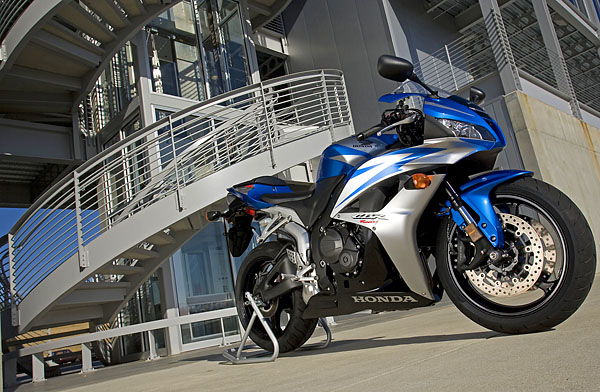
Honda’s elegant solution to the problem of abrupt off-on throttle response which has plagued the CBR line since the adoption of fuel injection also somewhat obviates the need for a slipper clutch. The intake-air control valve (IACV) is controlled by the ECU, and even when the throttle butterflies have been completely closed by the rider’s right hand, the IACV can open to allow some air into the intake ports (bypassing the throttle butterflies). Combined with a little bit of additional fuel (also controlled by the ECU), this valve works to smooth the transition from closed throttle to open throttle (or vice versa) by making the transition more gradual. It works just as intended, and the Honda now has one of the smoothest off-on throttle transitions in the class. That alone would be a huge leap forward from last year’s bike (the abrupt transition was one of our few major complaints about the ’06 CBR600RR), but the IACV serves another function – that of reducing engine braking. In fact, many of the engine braking reduction systems used in MotoGP operate under similar principles – that is, when the throttle is closed and the rider is braking, allowing a small and precisely controlled amount of air and fuel into the engine can reduce the engine braking to a less intrusive level, one less likely to lock the rear wheel or cause chatter. In this area the IACV also works superbly, and I was unable to induce rear-wheel chatter or lockup without purposely making aggressive and sloppy downshifts. Pretty impressive from a tiny air valve attached to the throttle bodies, one that probably weighs no more than a couple of ounces! The new transmission has also been redesigned to reduce gear lash, which is another contributing factor in causing abrupt off-on throttle transitions.

The styling of the new model is an evolution of the previous generation, which Honda tells us was mainly dictated by the demands of the wind tunnel. The new bike’s ‘face’ is similar to the ’06 model (although overall fairing area is reduced), with slightly smaller headlights straddling a large, centrally-placed ram-air duct. The tail section, too, is similar to that of the old bike, only slimmer and more stylized, with similar modifications to the appearance of the under-seat muffler. Only the fairing side panels are radically different, replacing the ’06 bike’s somewhat slab-sided look with a minimalist design that reveals large areas of the underlying engine, cutting fairing weight and enhancing cooling at the same time. Overall, the new bike is extremely attractive to my eyes, especially in the new blue and silver color scheme (my favorite by far). At the same time, the CBR “DNA” is well in evidence, and no one will mistake this bike for anything but a Honda.
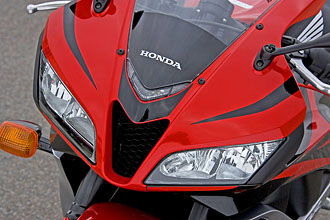
Ergonomics were modified with the intention of improving rider comfort, with higher bars and a re-designed seat compared to the old model. This slightly more upright seating position is less fatiguing for the rider, making me wonder how much input Doug Toland had in this area of the bike’s developement. Endurance racers (Toland’s background), for logical reasons, tend to be much more concerned with comfort than sprint racers do.
So after a day of riding the new Honda on the track, how can I sum up the bike’s position in the ultra-competitive 600 class? The new bike certainly retains the characteristics for which Honda sportbikes are well known, namely being easy and predictable to ride for anyone from beginner to expert. However, Honda has greatly increased the new CBR600RR’s performance at the racetrack, while trying to maintain or even improve its utility as a streetbike. Did they succeed? I can give an unequivocal YES to the question of improving the racetrack function, but the street part of the equation will have to wait a little bit longer. With its midrange-heavy motor and slightly more comfortable riding position, I have a feeling the CBR will be excellent on the street, as well. I can’t wait to get a bike for street testing.
After ignoring, to some extent, the trend of its competitors to develop ever more extreme racebike-influenced 600s, Honda has come out swinging in a way that to me epitomizes the company’s famed engineering expertise – by saying “we can build a better track bike, without sacrificing utility”. The no-compromises mentality seems to have worked in this case, and I think the middleweight sector just got a whole lot more competitive.

For additional details and specifications, visit Honda’s web site here. U.S. base MSRP of the 2007 CBR600RR is $9,499. The bike should be available at U.S. dealers in April, 2007.





